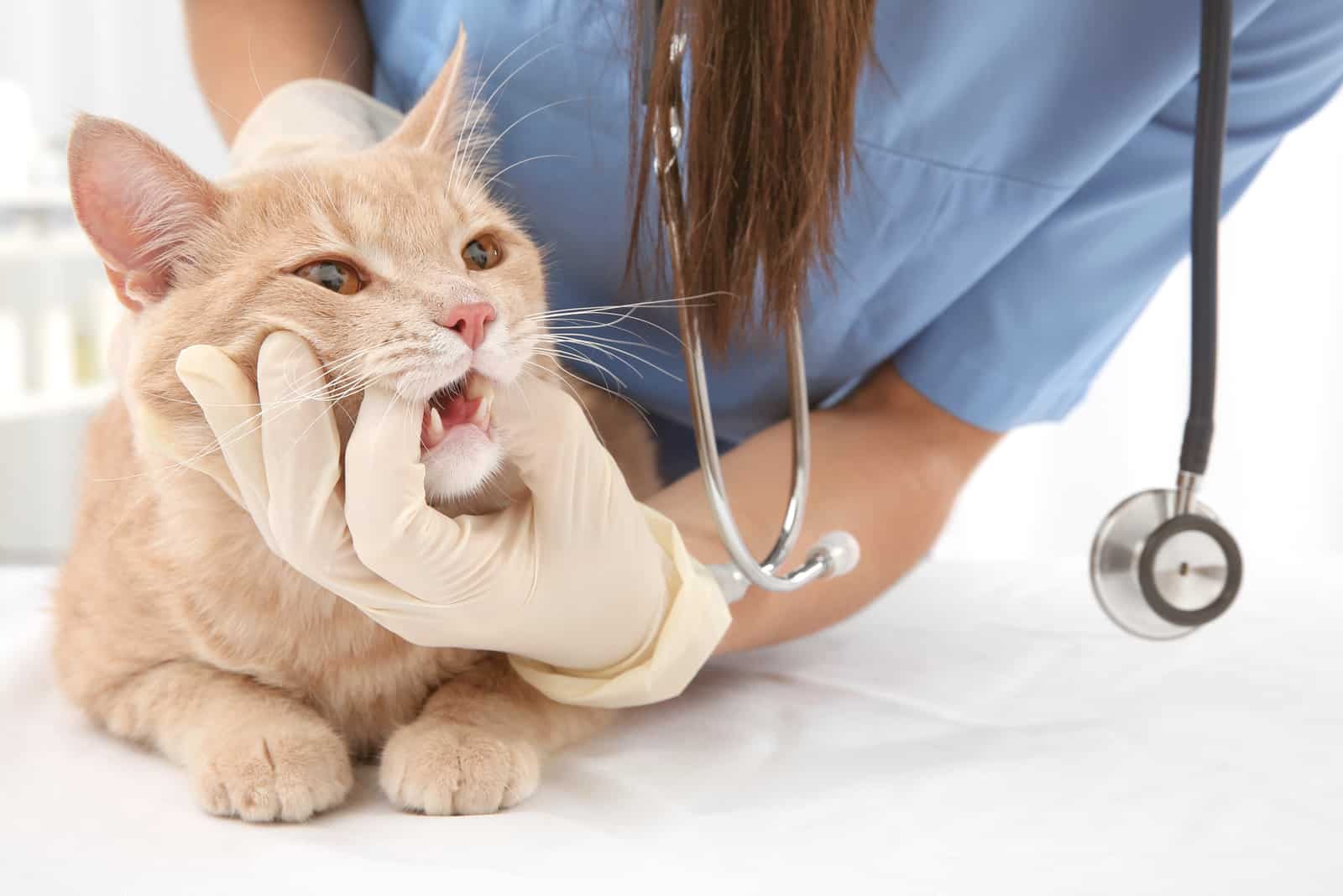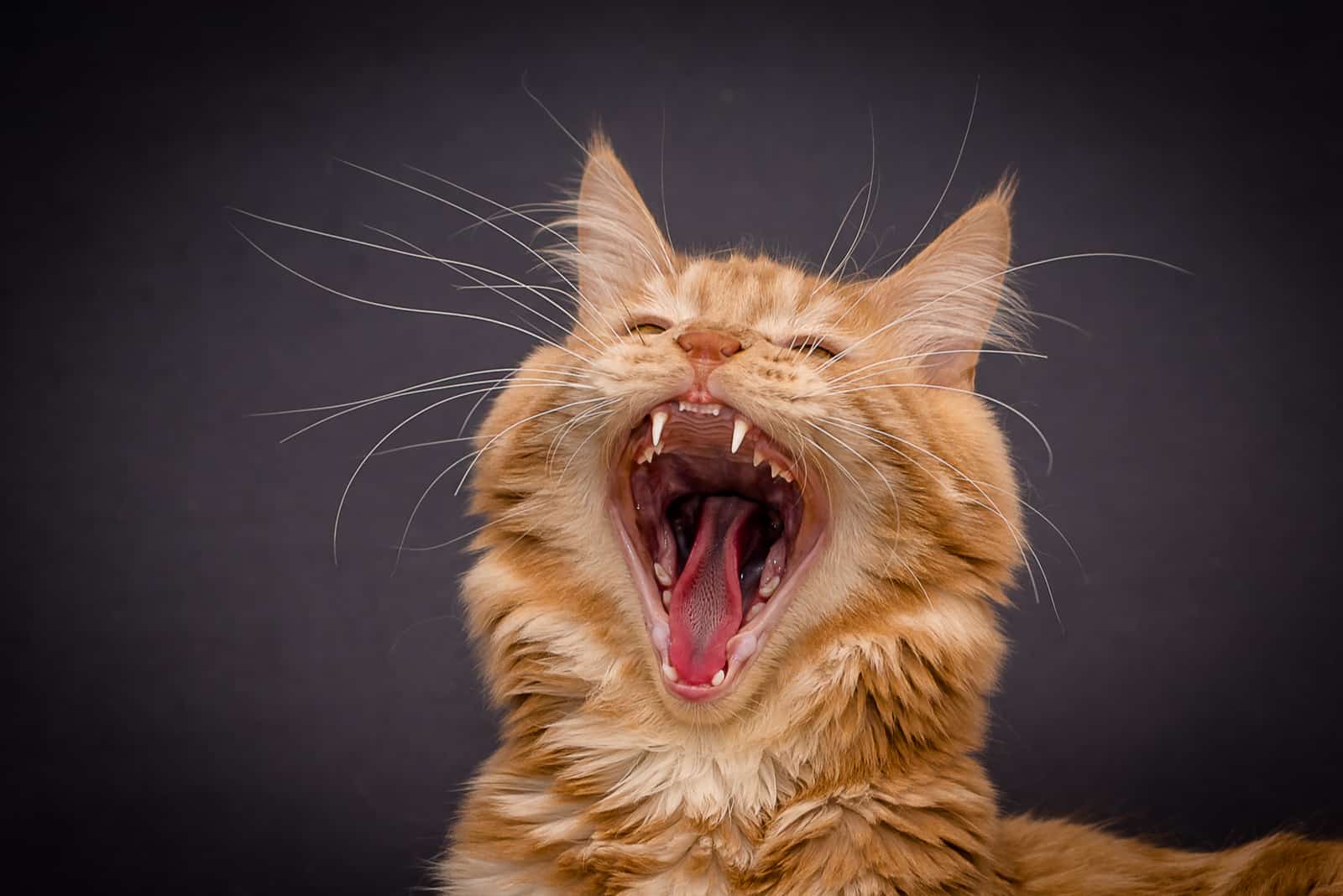Cat Teeth Age Chart: How Old Is My Cat According To Her Teeth?

We can all agree that cats are adorable, especially when they are just little kittens dependent on their mother. Watching them grow up is so rewarding.
Have you ever thought about the other things that change during a cat’s development, beyond size? What about cats’ teeth?
When I first heard that we could actually calculate our cat’s age according to their teeth, I was a little bit skeptical, but now I see that it’s totally true.
The state of a cat’s teeth can show you approximately how old your cat is and whether she might have some health issues.
So, by reading this article, you will get to know the cat teeth age chart in detail.
If you are wondering why you should know the exact age of your cat, well, you should because her age is the indicator for the proper care and adequate food.
Hopefully, after you read this article, you will go and check out your feline friend’s teeth!
Cat Teeth Age Chart: What Can We Find Out?

Many people are not owners of a cat from the moment she is born, so they can’t always be sure exactly how old it is. In cases like this, some specific features can be helpful in determining a cat’s age.
One of these factors is the kitten’s teeth. By analyzing the cat teeth age chart, we can successfully determine how old the cat is. When we are sure about the cat’s age, we can establish proper care for our beloved pet.
Let’s look up the cat teeth age chart and see what the dental situation is for your kitten’s developmental stages.
[table id=1 /]
By using the cat teeth chart, we can easily determine how old a cat is.
How Many Teeth Does a Cat Have?
Like humans, cats have a set of so-called baby teeth or deciduous teeth that are not permanent. Cats have 26 baby teeth in total.
After these teeth fall out, cats gain their permanent teeth. Adult cats usually have 30 permanent teeth.
Cat Teeth Through All Developmental Stages
So, during their lives, cats have two sets of teeth: baby teeth and permanent teeth.
What is the difference between a cat’s adult teeth and a kitten’s teeth? Let’s first find out something about cat’s teeth at an early age.
STAGE 1: Cats’ Teeth At An Early Age

When they are just born, kittens have no teeth. In this early period, the mother cat feeds the kittens with her milk. Until they are around 4 weeks old, they drink only milk from the mother cat.
After this period, kittens start to eat solid food, and this is when their first teeth show. The first ones that show are the teeth in front, and then come the teeth in the back.
By the time they are around 8 weeks old, cats have 26 baby teeth in total.
This period is followed by a phase in which kittens lose their baby teeth and gain their permanent teeth.
STAGE 2: Kittens’ Baby Teeth Are Replaced By Permanent Teeth
When the kitten’s age is between three and four months, baby teeth are replaced by permanent teeth.
In the process of losing baby teeth and gaining permanent teeth, cats might feel a bit of pain, and their gums might get swollen. In some cases, a clear sign that a cat is gaining new teeth is that her breath will have an unusual smell.
So, how can you tell for sure your cat is in the middle of the teething process? These are some of the most common signs that show your cat is teething:
• Cats sometimes simply swallow their baby teeth, but they can also leave their baby teeth anywhere, so a cat’s owner might find a lost tooth on the floor.
There is no need to worry if a cat swallows a baby tooth – cats will digest them easily, and it will not cause them any pain.
• Sometimes, a cat might be nervous because her mouth and gums are sore.
• Cats can also refuse food they usually like to eat if it is not easy to chew.
• In some cases, cats might suffer from bleeding of the gums, which is not dangerous.
STAGE 3: Your Cat Now Has All Of Her Permanent Teeth

How can you tell if your cat has all of her permanent teeth? Well, if the teething process is done, your cat friend should have 30 permanent teeth in total:
• 12 incisors
• 4 canines
• 10 premolars
• 4 molars
In both the upper and the lower jaws, cats have 6 incisors, 2 canines and 2 molars.
The only difference is in the number of premolars – while there are 6 of them on the upper jaw, a cat has just 4 premolars on the lower jaw.
For cats to be able to hunt and eat, their teeth need to be highly evolved. Every tooth has its specific function. Cats use their incisor teeth to drag and tear the prey.
Using their canine teeth, cats can kill their prey. While cutting up and chewing the food, cats use their premolar teeth. Finally, the function of cats’ molars is for chewing the prey.
What Does Proper Dental Care For Your Cat Include?

If you are a responsible cat owner, I am sure you are taking good care of your pet’s vaccination schedule, and you have also thought about whether you should neuter or spay your cat.
Well, just like you take care of these health issues, you should also pay special attention to your cat’s dental care.
Cats need proper dental care to prevent the appearance of tartar, which can lead to periodontal disease. This medical condition can be serious and demands proper medical care.
If not properly treated, periodontal disease can lead to feline tooth resorption, which is the main reason why cats lose their teeth.
Pet owners are advised to take their cat for a visit to the vet if they notice any of the following signs:
• Bad breath
• Tooth discoloration
• Weight loss
The most important step in avoiding serious dental problems for cats is proper and constant dental care. A dental care routine for cats at home includes brushing cats’ teeth regularly.
The best time to establish a dental care routine is at an early age – in this way, the cat will learn very early that the owner is not trying to hurt her and that tooth brushing is helpful and necessary.
However, some cats will never accept having their teeth brushed, so today there are many additional dental products that enable the proper dental care for cats.
Some of these dental products are dental treats and supplements and dental food that stop bacteria from growing in a cat’s mouth and reduce the appearance of tartar buildup.
So, What Does The State Of A Cat’s Teeth Say About The Cat’s Age?

Older cats usually have more stained teeth than younger cats. If a cat has white teeth, she is probably not older than a year.
Between one and two years old, cats might have yellow teeth. If cats have tartar on their teeth, they are usually between 3 and 5 years of age.
When we see that a cat is missing one or more teeth, we can conclude that the cat is old. Still, this doesn’t always have to be true, because some younger cats might also lose their teeth due to trauma or health issues.
All these rules are not universal since every cat and her history and health state are unique.
A Cat Teeth Age Chart Is Helpful In Creating A Healthier Life For Your Pet
It is important for every cat owner to be aware of their cat’s age – it enables the owner to know the approximate life expectancy of their feline friend.
Although they are famous for their longevity, in the period between seven and ten years old, cats usually become less active and might experience some health issues.
Once again, the cat teeth age chart can be a helpful tool in determining a cat’s age.
A missing tooth or change in the color of a cat’s teeth should not be ignored since it can clearly show a change in the cat’s medical state.
So, every cat owner should be aware of their cat’s age and take care of the cat’s needs in accordance with that age.
Other Ways We Can Tell A Cat’s Age

Besides using the cat teeth age chart, there are some other ways we can learn how old a cat is. For example, we can learn a lot from a cat’s muscle tone – while younger cats usually are muscular, older cats show much more extra skin.
Cats’ eyes can also be an important indicator of age. Young cats usually have very bright eyes.
On the other hand, an aging cat might show cloudiness in the eyes, which in some cases can also be a sign of serious health issues.
To be sure the cat is healthy and well, the best idea is always to consult a DVM (doctor of veterinary medicine).
Calculating A Cat’s Age In Human Years
Most people are familiar with the calculation widely used for both dogs and cats in which one year of our pet’s life is equal to seven human years.
Part of this statement is true – pets do age faster than humans. But not every year of a cat’s life is equal to seven human years.
The cat’s first year of life is equal to 15 human years, which is significantly more than 7.
Furthermore, it is believed that the second year of a cat’s life is equal to nine human years, and every following year of a cat’s life is equal to four human years.
Conclusion

So, we have learned how the cat teeth age chart is a huge help in establishing good health care for your loved pet. To provide a long, quality life for a cat, it is crucial to be aware of the cat’s age.
According to the cat’s age, the owner can make decisions like what kind of cat food is the best for their pet, and how often the cat should be getting check-ups at the vet.
Don’t ever forget about the importance of dental care for your cat!
Finally, it is very important to remember that a cat needs to be cared for at every life stage – from the period she is a small helpless kitten to when she becomes a senior cat.
Now you know how to determine your cat’s age. But what about your cat’s breed? If you’re unsure which breed your feline might be, check out this article on how to determine your cat’s breed!






